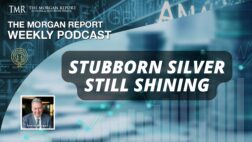Over the last several years I have been asked about my thoughts on the Barclay’s iShares Silver Trust and this is something that has been discussed in our reports as well as many of the interviews that I have done. In 2009 Jim Puplava of www.FinancialSense.com and I discussed was that Barclays changed the words in the original prospectus from “Silver Bullion” to just “Silver,” which reading as a lawyer would, begs the question Why? To me it implies there might be other silver investments that count but are not necessarily bullion.
One benefit I stated early on is that the silver ETF eliminates two major problems of purchasing large quantities of silver.
- Where do I store it once I have bought it?
- How can I buy a large quantity at once in the “physical” market?
But I never will consider it to be a primary silver investment. Knowing that the SLV is ALWAYS cash settled should raise an eyebrow or two. Certainly the SLV was set up primarily for larger institutional types to participate in the silver market. The tax consequences are also something any investor would be smart to determine before making an investment.
On balance it does bring attention to the silver market, has provided much more participation into the metals market, and has a fairly low risk if all you want to achieve is a paper gain. But under no circumstances do I consider it to be a silver investment. SLV, as with a mining stock, futures or options contract, or anything else that you do not hold in your own hand, is a derivative!
There are other ways to buy silver that involve what I consider to be better alternatives, such as the Sprott Physical Silver Trust which allows the investor to take delivery of the real silver. Also, the Central Fund of Canada (CEF) does have the real silver and gold they report, but in this case you cannot take the metal you must settle in cash. James Turk and others have also addressed the unanswered questions about these ETFs in earlier interviews. In fact, when it finally was introduced into the investment arena a few years ago, I asked James to help me with some of the finer points on the SLV.
As many others and I have pointed out numerous times, there are bar lists and the bars are likely real and do exist. During the interview with Jim Puplava, I gave one of numerous possibilities that could put bars into “inventory” and yet still have several claims against them. Again, the issue with them is whether the ETF really owns them free and clear or they are encumbered or otherwise compromised.
Another point is, the SLV can be “shorted” and this silver does not have to exist in inventory.
Let us think about the paper precious metals markets; in my case obviously it would be focused on silver. I imagine myself standing in a large football stadium—something like the Rose Bowl would do nicely—and all participants with silver holdings (metal or paper) of one thousand ounces or greater fill the stadium. I draw a line at the fifty-yard line. I take all the silver on paper and place it on one side of the fifty-yard line; all the physical silver we place on the other side of the fifty-yard line. Then I calculate the value of each side.
Guess what! The dollar amounts of the two sides will not match—not even close—I guarantee it! There is far more paper silver than physical silver. This can easily be proven and has, by some of my earlier articles and by numerous other writers in this space. In fact some of the best known in the precious metals space have told the CFTC that the ratio of paper silver to physical silver is about 100 to 1.
The controversy surrounding the gold and silver ETFs continues and there are proponents both for and against the GLD and SLV. In an effort to remain consistent personally, my original “take” on the silver ETF remains, which is to state that any “investment” involving silver would have an overall positive effect because it would draw more and more attention to both professional and private investors that indeed silver is not only a worthwhile investment but also has all the monetary qualities of gold and has an industrial component that will remain, under any economic conditions.
For a good presentation of differing viewpoints, I suggest reading A Problem with GLD and SLV ETFs, by Trace Mayer, whose interview I conducted in Phoenix at the Silver Summit.
The bottom line is you can trust silver in your hand that you own. As far as Silver Trust’s are concerned not all of them are created equally. Be careful and due your own investigation, saving a little money to get a better deal may end up being a raw deal.



